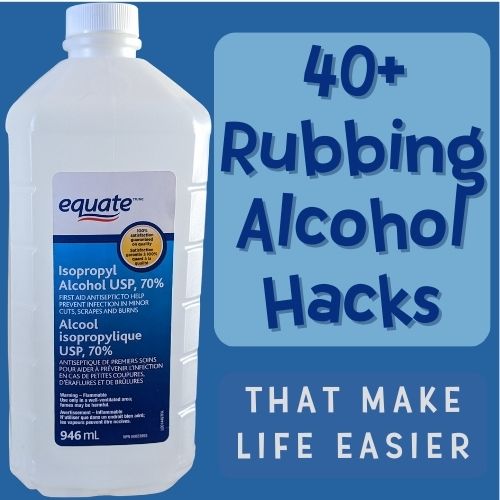Have you ever found yourself in a sticky situation, quite literally? Maybe tree sap dripped all over your favorite lawn chair, or your kids put stickers all over the walls or got creative with permanent markers. In any case, these amazing rubbing alcohol hacks can be a lifesaver when it comes to removing stubborn stains and cleaning up messes.
There are so many ingenious uses for rubbing alcohol that you might not have even considered before. I want to share some of my favorite rubbing alcohol hacks that have saved me time, money, and headaches over the years. From removing grease stains to disinfecting surfaces, these tips are sure to come in handy!
As an Amazon Associate I earn from qualifying purchases. This means if you click on a link and buy something I’ve recommended, I get a small commission at no additional cost to you. You can see my full Disclosure Policy here.
Rubbing alcohol vs isopropyl alcohol
Rubbing alcohol contains isopropyl alcohol, but the concentration of isopropyl alcohol is 100%, while a bottle of rubbing alcohol is less concentrated because of the addition of water and possibly other ingredients. Otherwise, the two liquids have similar properties. As a disinfectant, 70% concentration of alcohol is the most effective at killing pathogens. Any higher or lower percentage will be less effective for disinfecting.
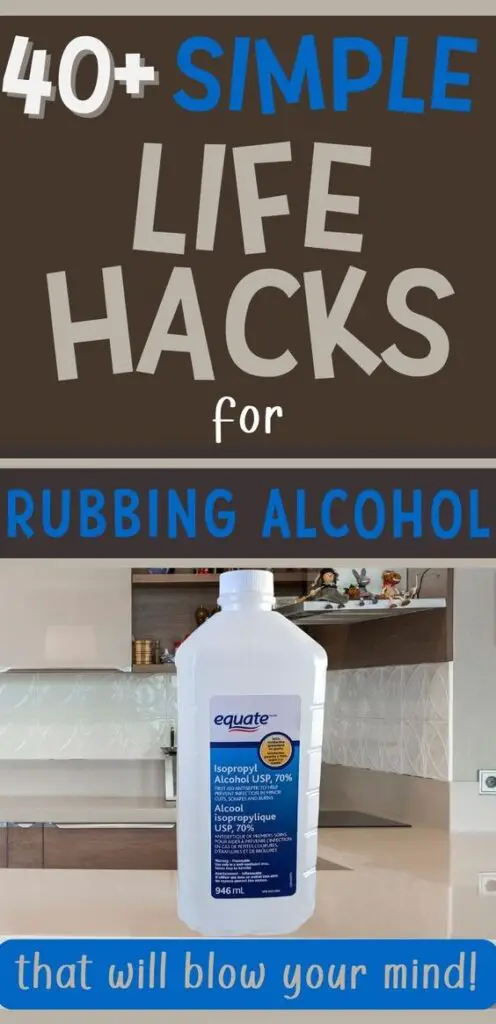
What is rubbing alcohol used for?
Everyone knows that rubbing alcohol is a staple in first aid kits as an antiseptic and for disinfecting. But did you know rubbing alcohol is one of the most versatile products you have in your home? There are so many ways to use rubbing alcohol, and you might not even know it.
Rubbing alcohol is not only useful for personal care. Its solvent properties can be used for a wide range of cleaning tasks, from glass to stainless steel to floors to laundry. It’s also an effective deodorizer and deicer.
In fact, there are so many ingenious uses for rubbing alcohol that you might not have even considered before. In this post, I’ll be sharing some of my favorite rubbing alcohol hacks that have saved me time, money, and frustration over the years. From removing grease stains to disinfecting surfaces, these tips will come in handy for anyone looking to make their life easier.
Safety Tips
Do not mix with bleach
Never combine bleach with rubbing alcohol. It can release dangerous chloroform gas that may irritate or damage your lungs. Symptoms of chlorine gas exposure include burning in your eyes, throat, and lungs. The only thing you should mix with rubbing alcohol is water.
Keep away from fire
Isopropyl alcohol is extremely flammable. Though it dries quickly, spraying it on upholstered furniture, carpets, fabrics, clothing, and mattresses creates a fire hazard. Vapors that linger in the air are also highly flammable. Avoid using rubbing alcohol around open flames.
Household Rubbing Alcohol Hacks
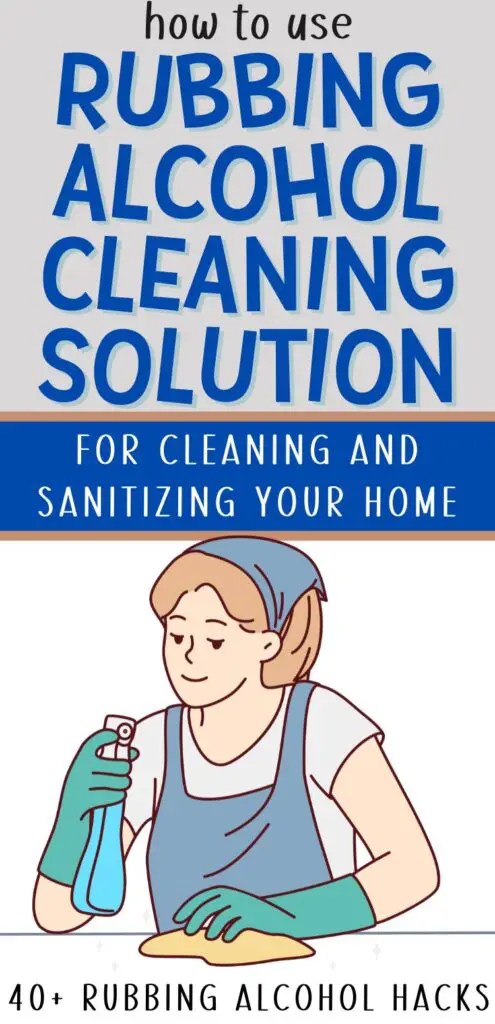
Rubbing alcohol cleaning hacks
Degreaser
Rubbing alcohol is a solvent that has the ability to cut through heavy grime build-up, grease, and oils. Rubbing alcohol is a great way to clean greasy grime buildup on walls, range hoods, appliances and glass or laminate cabinets. Simply spray and wipe.
Disinfect countertops, surfaces and high touch areas
Rubbing alcohol has antimicrobial properties against bacteria, fungi, and viruses. It has a neutral PH and is safe for natural stone surfaces. Clean the surface with soap and water then simply spray the surface you want to disinfect. Let it air dry. You can also use it to sanitize high touch surfaces like light switches, door knobs and remotes.
Related Post: 3 Simple DIY disinfectant sprays that work!
Remove ink (and other) stains from countertops
Did ink from a plastic bag transfer onto your countertop or your kids go wild with Sharpies? Rubbing alcohol is safe for most countertops. Pour some rubbing alcohol on the ink stain and let sit for a few minutes. Wipe with a clean cloth or paper towel. The stain will disappear.
Glass and mirrors
Rubbing alcohol can be used for a streak-free finish on your glass surfaces. Mix 1 part water with 1 part rubbing alcohol in a spray bottle. Try not to clean glass in direct sunlight to avoid streaking. Start from the top of the window and work your way down.
Remove hairspray buildup
Rubbing alcohol makes removing hairspray buildup a breeze. Simply spray it on the area with the buildup, let it sit a few minutes to dissolve, and wipe it away with a clean cloth or paper towel.
Floor cleaner
Spray a solution of equal parts water and rubbing alcohol on the floor. Mop it up for a clean, streak-free finish. It dries quickly, is safe to use, and is an effective solvent. It will also disinfect your floor.
Related Post: The absolute best floor cleaning machines for your home
Stainless Steel Appliances
Rubbing alcohol is the key to shiny stainless steel because it evaporates quickly without leaving a residue. It also removes greasy grime. Mix one part water with one part alcohol. Spray it on the surface and wipe it off with a microfiber cloth in the same direction as the stainless grain to disinfect and add shine.
Chrome
Rubbing alcohol is great for buffing your sink and shining up chrome fixtures. It disinfects and dries quickly, leaving no spots.
Remove sticky residue
Common adhesives are soluble in alcohol. If you have sticky residue from tape, labels or stickers on glass, fabric or other non-finished surfaces, simply soak the adhesive with rubbing alcohol, let sit, then scrape off with a razor blade or plastic scraper. Rubbing alcohol can even dissolve gum!
Related Post: How to clean flip flops (even when they stink)

Stain Removal
Alcohol is a degreasing agent. The toughest stains are greasy and oily in their makeup. It’s also effective against ink stains. The solvent properties of rubbing alcohol break down the components of the stain better than soaps and detergents.
Carpet stains
Soak the stained area with rubbing alcohol and let sit for a minute or two. Blot with clean white towels or cloths until the stain is lifted. Let dry.
Clothing stains
To safely remove difficult stains like oil, ink, grass, grease, or sap from fabrics, blot them out using rubbing alcohol and a cotton piece of cloth. Do not use on acetate, rayon, wool or silk fabrics.
Upholstery stains
Vacuum the upholstery well before spraying the stain with rubbing alcohol. Rub the area with a soft white cloth until the stain is lifted, then let air dry. If it feels stiff after drying, use a stiff brush in circular motions to fluff it.
Remove ink from dryer
Pen exploded in the dryer? Rubbing alcohol is an effective way to remove ink from both the dryer’s drum and the paddles. Wipe the affected areas of the dryer with a clean cloth that has been saturated with rubbing alcohol. If it’s particularly stubborn, try soaking a magic eraser with alcohol for a double whammy.
Related post: 54 Hydrogen peroxide hacks you need to know
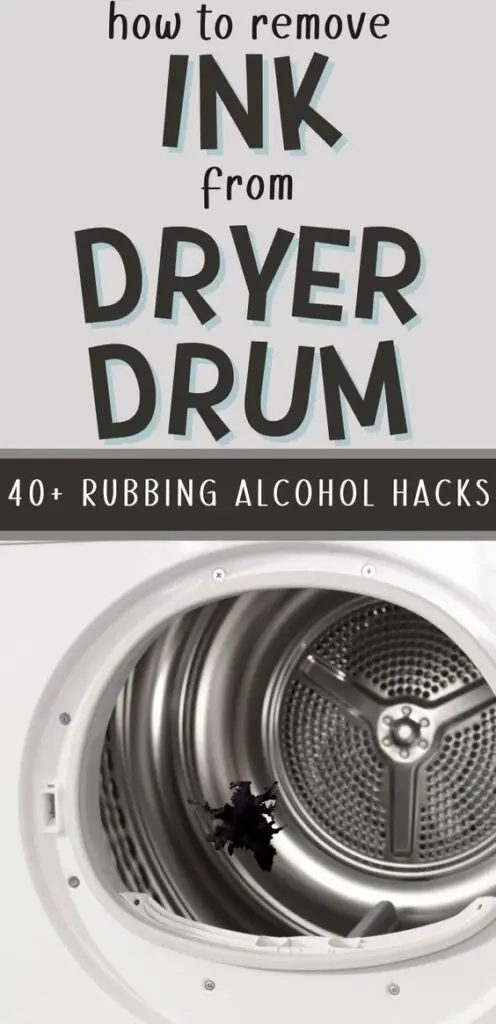
Other home uses for rubbing alcohol
Remove latex paint drips
Use a rag soaked in rubbing alcohol to remove paint drips from floors and windows (even dried ones). Additionally, if you don’t know what kind of paint is on a wall, use a rag with a bit of rubbing alcohol on it and rub at a small spot of the painted area. If the rubbing alcohol lifts the paint and transfers it to your rag, the existing product is latex and you’re good to paint with latex paint. If the rubbing alcohol doesn’t break down, then you’re dealing with an oil based paint and will need to prime using the proper product before going ahead with latex paint.
Deodorizing shoes
For stinky shoes, sandals and boots, spray the inside of the shoe with full strength rubbing alcohol and let it completely dry. The alcohol will kill the bacteria that make the shoes smell.
Related post: DIY shoe deodorizer: 16 ways to refresh stinky shoes
Deodorizing furniture and carpets
Spray furniture and carpets with rubbing alcohol to get rid of unpleasant odors. Test a small area before applying to the entire area to make sure it’s safe on the fabric. Also ensure there are no open flames in the area before spraying.
Defrosting freezer
Use rubbing alcohol to easily defrost your freezer. It’s low freezing temperature will help melt the clumps of ice quickly and make them easier to remove. Take everything out of the freezer before pouring undiluted rubbing alcohol on the largest chunks. One the ice has been removed, dry with a clean cloth and replace the items in your freezer.
Health and Beauty Rubbing Alcohol Hacks
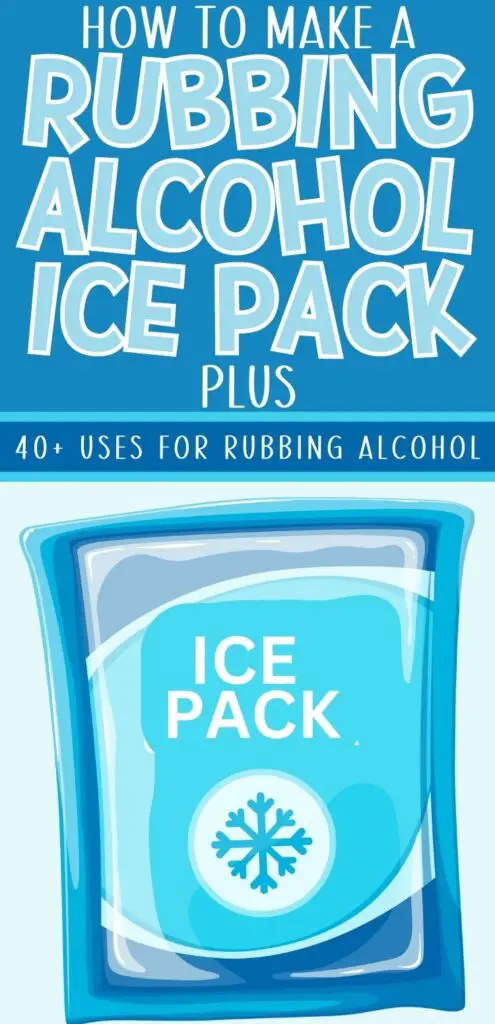
First Aid
Disinfecting
Use rubbing alcohol to sterilize tweezers, thermometers, scissors and medical tools, but never to clean wounds or injured skin. It can cause tissue damage and actually slow the healing process, and it hurts like heck when alcohol enters an open wound. You can also use it to disinfect earrings and nail clippers.
Ice Packs
Mix 2 parts water with 1 part rubbing alcohol in a ziplock bag and put it in the freezer for a few hours. Once frozen, you will have a reusable flexible ice pack that can be placed anywhere on the body.
Bug bite relief
We were in Roatan this winter, and they have no-see-ums (sand flies) that drive you to the point of insanity with their incredibly itchy bites. We poured some rubbing alcohol on a washcloth and then applied that to our raw ankles. It soothed them and took the itch away. I 100% vouch for this.
Prevent swimmer’s ear
If you are prone to swimmer’s ear, put a few drops of rubbing alcohol in each ear after swimming to remove water in ears. The alcohol combines with water in the ear and then evaporates, drying the ear canal, while also keeping bacteria from growing.
Mild yeast infections on skin
If you feel an itchy yeast infection starting anywhere skin meets skin, try applying some rubbing alcohol to the area to kill the fungus. Just apply and let dry. This should only be done on unbroken skin. If the infection has progressed, it’s better to see your doctor.
Personal Care
Astringent
An astringent is a substance that draws water out of tissues. In skin care, using rubbing alcohol after cleansing can temporarily tighten the skin, shrink pores, and remove oil. However, astringents can be drying, and are not suitable for every skin type.
Nail care
Rubbing alcohol is a solvent – meaning it breaks things down. Alcohol softens and breaks down nail polish, so you can use it to remove regular nail polish. It may take a while longer than acetone nail polish remover, but it should get the job done so you don’t have to run out to the store.
Deodorant
Rubbing alcohol can be a lifesaver if you’re out of deodorant. Odor is caused by bacteria, and the alcohol will kill the bacteria. You can spray directly on your armpit, but don’t do it after shaving since it can sting.
Remove makeup
Rubbing alcohol is an excellent grease cutter, so you can use it to remove makeup such as lipstick and oily foundation. You can also use it to clean and disinfect makeup brushes.
Cool off
Rubbing alcohol evaporates from skin quickly and takes the heat with it, leaving a temporary cooling effect. It also dries out your skin and helps close the pores, which can prevent sweating. Dab a bit of alcohol on your wrists, ankles, neck and forehead to cool down quickly. It will also remove any oily residue on your skin that is making you feel hotter.
Related post: What to do When Your House is Too Hot in Summer
Outdoor uses for Rubbing Alcohol
Camping Uses
Fire starter
Soak cotton balls in rubbing alcohol and store them in a small jar to keep the alcohol from evaporating. When you’re ready to start your fire, place the soaked cotton balls onto dry leaves or twigs and apply a flame to get a fire going quickly. Rubbing alcohol is very flammable, so be very careful when starting your fire.
Disinfectant for campsite
Use rubbing alcohol to make cooking gear, eating surfaces and first aid supplies safe to use. Always let the material completely dry before using it, but rinse cooking gear with water before using.
Insect repellent
Alcohol is a very dehydrating and drying solvent. If you forgot your DEET, spray rubbing alcohol directly on mosquitoes, fruit flies, gnats and any other insects you don’t want near you. Be very careful if you are around a campfire, as rubbing alcohol is very flammable.
Garden Care
Plant pest control
Rubbing alcohol can kill mealybugs, aphids, spider mites, thrips, slugs, snails, and whiteflies by dehydrating and drying them out. Dilute 1 part rubbing alcohol into 20 parts water and carefully apply the solution to just the pests – do not coat the leaves in the solution.
Tool cleaner
To prevent the spread of plant diseases and to remove sap from garden tools, spray the garden tool with undiluted rubbing alcohol, wipe clean with a paper towel or cloth, then spray again and allow to air dry.
Cleaning resin from skin
If you’ve been handling plants that leave a sticky resin residue on your skin, rubbing alcohol will dissolve it quickly and easily. Simply soak a rag with rubbing alcohol and rub it on the sticky skin surface. Let sit for a minute and then wipe away.
Weed killer
Make your own weed killer using rubbing alcohol by mixing two tablespoons into a quart of water. It works as a weed killer because it dehydrates the weeds and they eventually die.
Car Care
Defrost your windshield
Rubbing alcohol has a freezing point of over -120 degrees Fahrenheit, so it can break up and melt ice on your windshield. Mix 1 part water and 2 parts rubbing alcohol together in a spray bottle and spray on your windshield for fast defrosting. It’s also a great cleaner for streak-free windows.
Frozen locks
As with defrosting your windshield, rubbing alcohol can melt ice frozen in locks. Use the same 1:2 ratio of water to rubbing alcohol to get the key in so you can unlock the door. I’ve even used it on my dog’s leash latch when it’s frozen.
Remove Tar & Sap
The solvent properties of rubbing alcohol breaks up and dissolves sticky sap and tar. But don’t use it undiluted as it can also dissolve paint. Use a mixture of 1 part rubbing alcohol to 3 parts water to safely get the sticky stuff off your car.
Miscellaneous Rubbing Alcohol Hacks
Electronics Cleaner
Use rubbing alcohol to disinfect high-touch surfaces like your phone, keyboard and computer mouse. Simply spray and wipe. It dries almost instantly, reducing the risk of liquid damage.
Computer and TV screens
Make sure the screen has been off and is cool. Lightly spray undiluted rubbing alcohol onto a soft, lint-free cloth (very important for not damaging the finish of the screen), and then use the moistened cloth to wipe the screen clean. Let it air dry.
Remove permanent marker
Remove new and dried permanent marker stains off with rubbing alcohol. It will remove marker stains from both fabrics and hard surfaces. Test a small area first to make sure it won’t remove the finish or damage the fabric.
Jewelry Cleaner
You can clean your jewelry using isopropyl rubbing alcohol. Fill a small bowl with alcohol – just enough to fully cover the piece you wish you clean. Leave the jewelry to soak in the bowl for a few minutes then place on a paper towel to dry. Alcohol dries completely clear on metal surfaces so there is no need to rinse it off with water.
Dissolve drain clogs
If your sink is clogged with a sticky mess, try pouring a cup of rubbing alcohol down the drain. The alcohol will dissolve greasy, sticky or oily clogs. Let sit for at least 15 minutes and follow with hot water.
Related Post: 42 Dawn Dish Soap Uses You Never Thought Of
Cleaning resin from glass or ceramic pipes
Submerge the pipe (and other pieces that have residue) in enough rubbing alcohol to completely cover. Let it soak until most of the resin is dissolved. Use a pipe cleaner soaked in alcohol to remove any traces of resin. Rinse with clean water and allow to completely air dry before using.
Remove hairspray buildup
Remove hairspray buildup from the floor, sink, walls, mirror and counter in your bathroom with rubbing alcohol. Just spray it on and then wipe it off with a clean cloth.
Remove hair dye from bathroom fixtures
Hair dye tends to end up everywhere in the bathroom. Apply some onto a cotton ball and rub it over the stained area, avoiding wood finishes and painted surfaces.
Related post: 22 Best House Cleaning Tools that Make Cleaning Easier
What you should NOT use rubbing alcohol on
To disinfect open wounds
When applied to an open wound, rubbing alcohol can cause tissue damage and actually slow the healing process. It’s better to wash the wound with cool, soapy water and rinse it under a stream of cool water. Once the bleeding has stopped, apply antibacterial ointment and cover the wound with a bandage.
Finished surfaces
Don’t use rubbing alcohol on painted, shellacked, lacquered, or varnished surfaces, including treated wood, unless you want to remove the finish. Rubbing alcohol is a solvent that can dissolve some finishes.
Synthetic fabrics
While isopropyl alcohol can be a great stain treatment on certain fabrics, certain delicate or synthetic fabrics like acetate, rayon, wool, and silk can be stained or damaged.
Try some of these rubbing alcohol hacks for cleaning, stain removal, deodorizing, personal care, first aid and so many other things! Put that unused bottle to work on tackling common issues in your home. Just remember to be very careful using rubbing alcohol around open flames and on finished surfaces.

